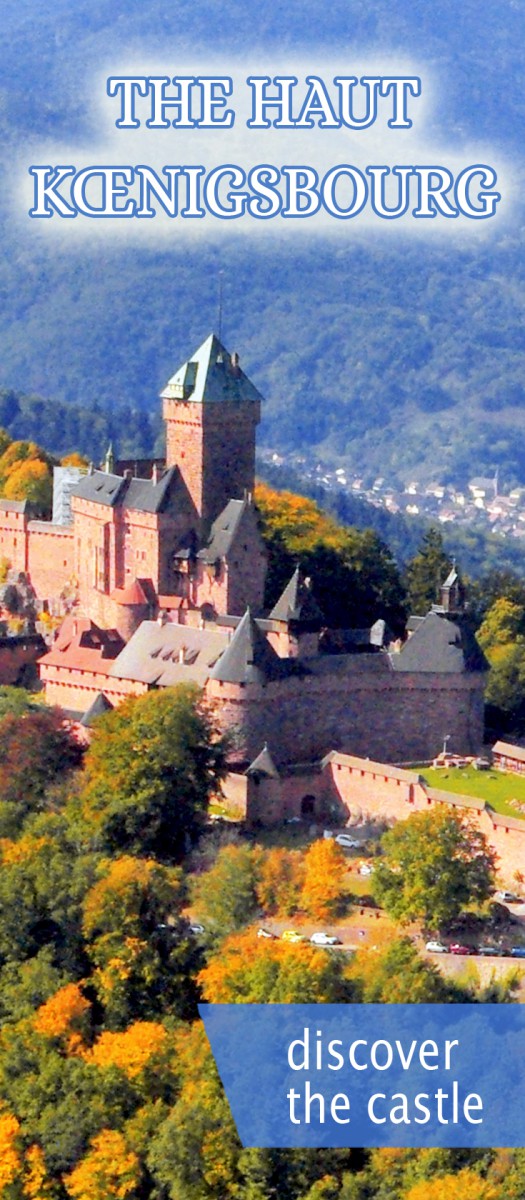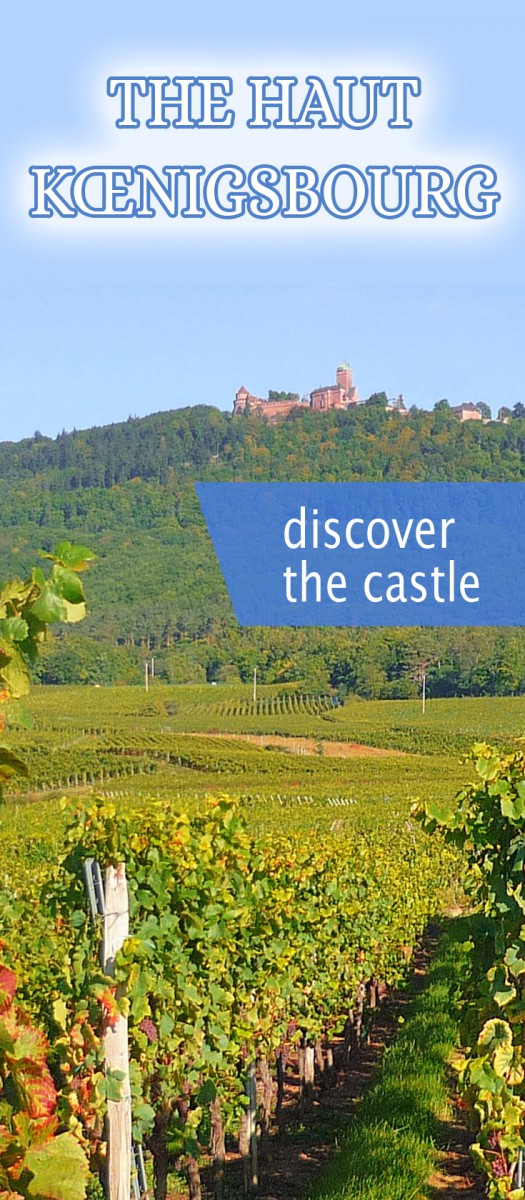At 757 metres high, the Haut-Kœnigsbourg castle dominates the Plain of Alsace. Its imposing pink sandstone structure stands out.
Ideally situated with the heart of the Alsace Wine Route winding at its feet, the fortified castle provides its visitors with a panoramic view over the Alsace Plain, the Black Forest (Germany) and, on a fine day, the Swiss Alps. The castle ranks among the most visited sites of Alsace.
👉 Get your entry to the Haut-Koenigsbourg Castle!
The Haut-Kœnigsbourg: A strategic position
The strategic position of the Haut-Kœnigsbourg means the castle has witnessed European conflicts involving local lords, kings and emperors such as the Hohenstaufens, the Habsburgs and the Hohenzollerns.
The current fortress has been rebuilt on the ruins of a medieval castle that was destroyed in 1462. Rebuilt during the same century, the castle was ruined again after being burnt down by the Swedish army.
In 1865, the town of Sélestat acquired the ruins before they were entirely renovated by German emperor William II.
The restored castle was inaugurated in 1908. Ten years later, it became French.
This mecca of tourism in Alsace welcomes more than 550,000 visitors each year more than 40% of whom are foreigners.
The history of the Haut-Kœnigsbourg castle
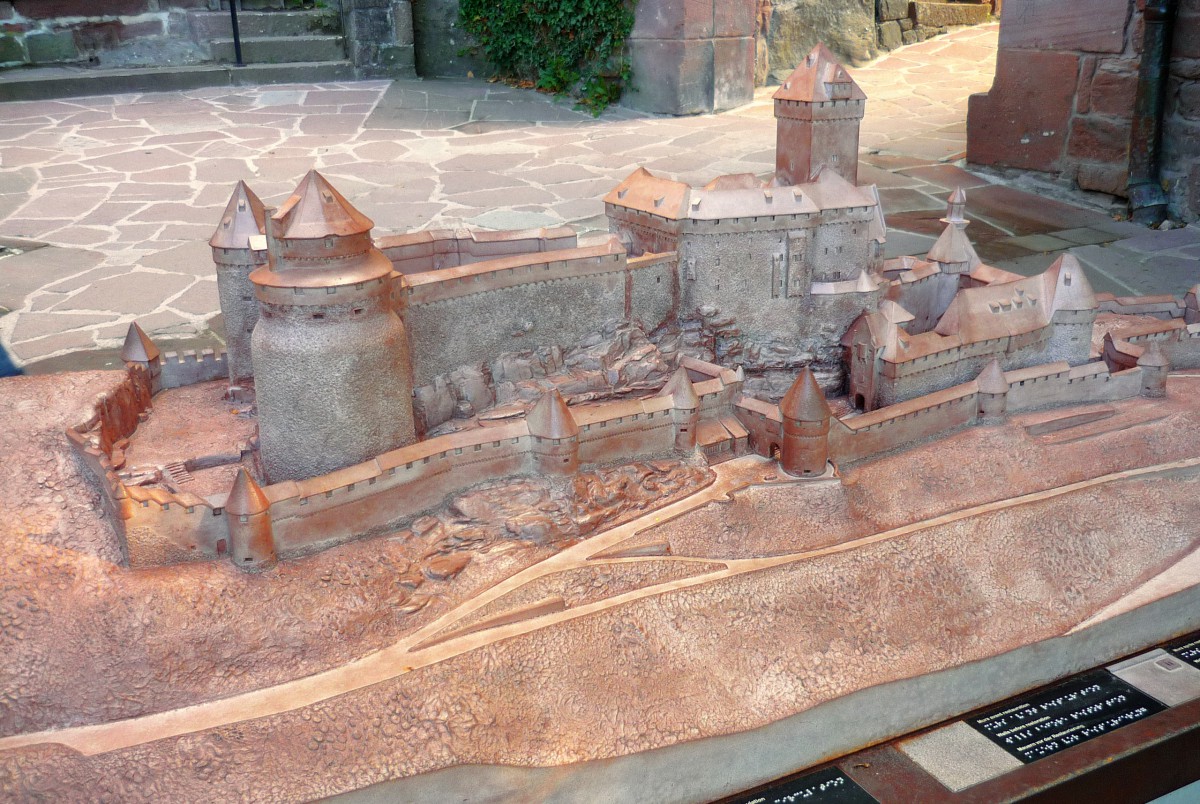
The castle was built in the 12th century by the Hohenstaufens and was first mentioned in 1147 by the name ‘Staufenberg‘.
Its strategic position above the Alsace Plain allowed its occupants to watch the main roads of the region and also to be used as an important site to which to withdraw.
In 1192, the castle changed its name to “Kœnigsburg”, meaning “royal castle” in the German dialect.
Later turned into a robbers’ hideout, the castle was besieged in 1462 by a coalition army conquering the towns of Colmar, Strasbourg and Basel. Consequently, the castle was dismantled.
In 1479, the Habsburg regime entrusted the stronghold to the local dynasty of the Tiersteins who refurbished it.
A new defensive system was integrated to provide better resistance to artillery attacks. The castle underwent a renaissance, hence its new name: Hohkœnigsburg (“Hoh” meaning “high”).
In 1633, during the Thirty Years War, the Swedish army ransacked and burned down the castle following a 50-day siege. The Haut-Kœnigsbourg was then abandoned for two centuries.

In 1862, renewed interest in the castle led to its listing as a Historical Monument.
Three years later, the neighbouring town of Sélestat acquired the site with the objective of rebuilding it. But the plan proved too expensive for the town, which gave up the ambitious programme.
The Kaiser’s ambition
In 1871, the castle and the whole region of Alsace were annexed by Prussia, and in 1899 Sélestat offered its beautiful ruins to Emperor William II.
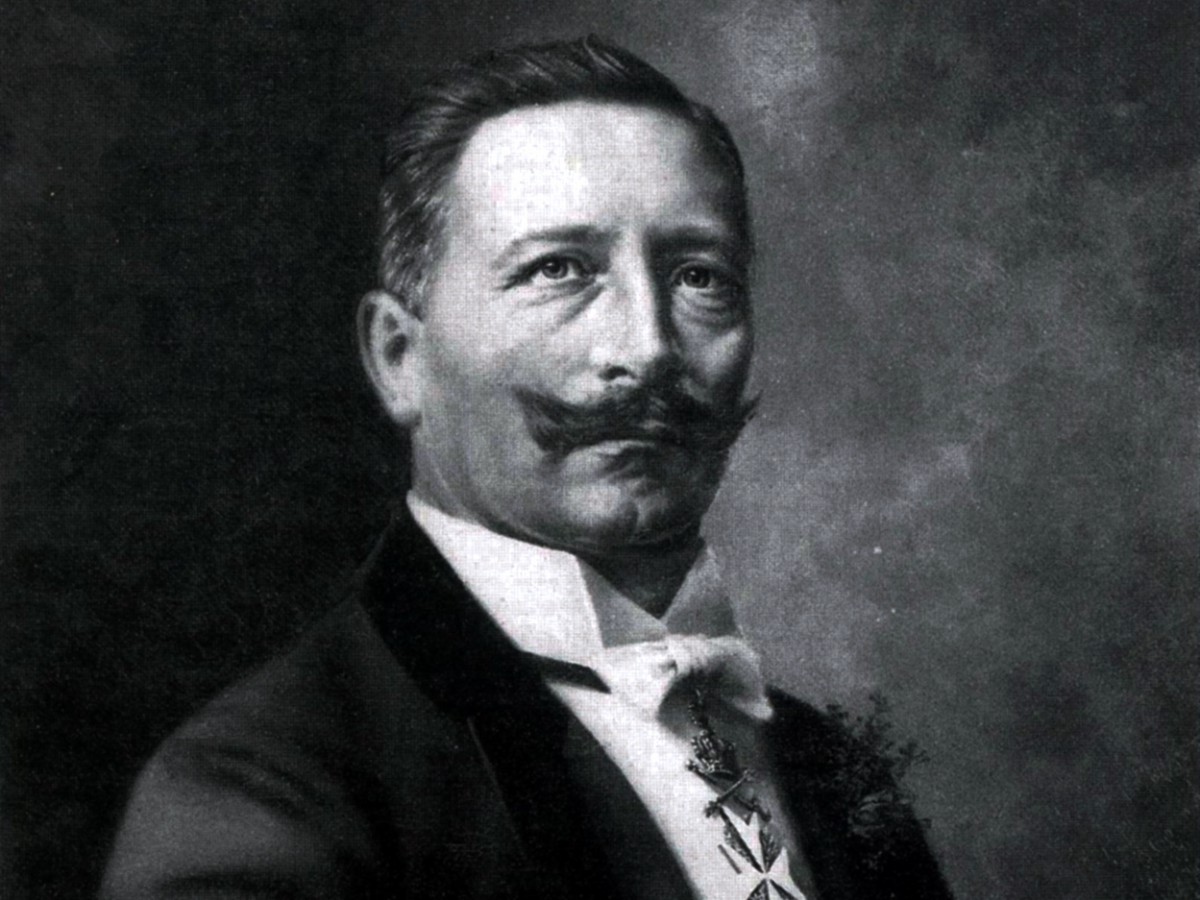
For the Emperor, this gift was an ideal opportunity to further his plan to Germanify Alsace and unite the region with the great German nation.
To mark the Western border of his empire, William II decided to commission an entire restoration of the Haut-Kœnigsbourg.
The Emperor’s personal ambition did not stop at the castle but extended to the cities of Strasbourg and Metz, where the Germans created remarkable German imperial districts.
Emperor William II commissioned the architect Bodo Ebhardt (an expert in feudal architecture) to restore the castle.
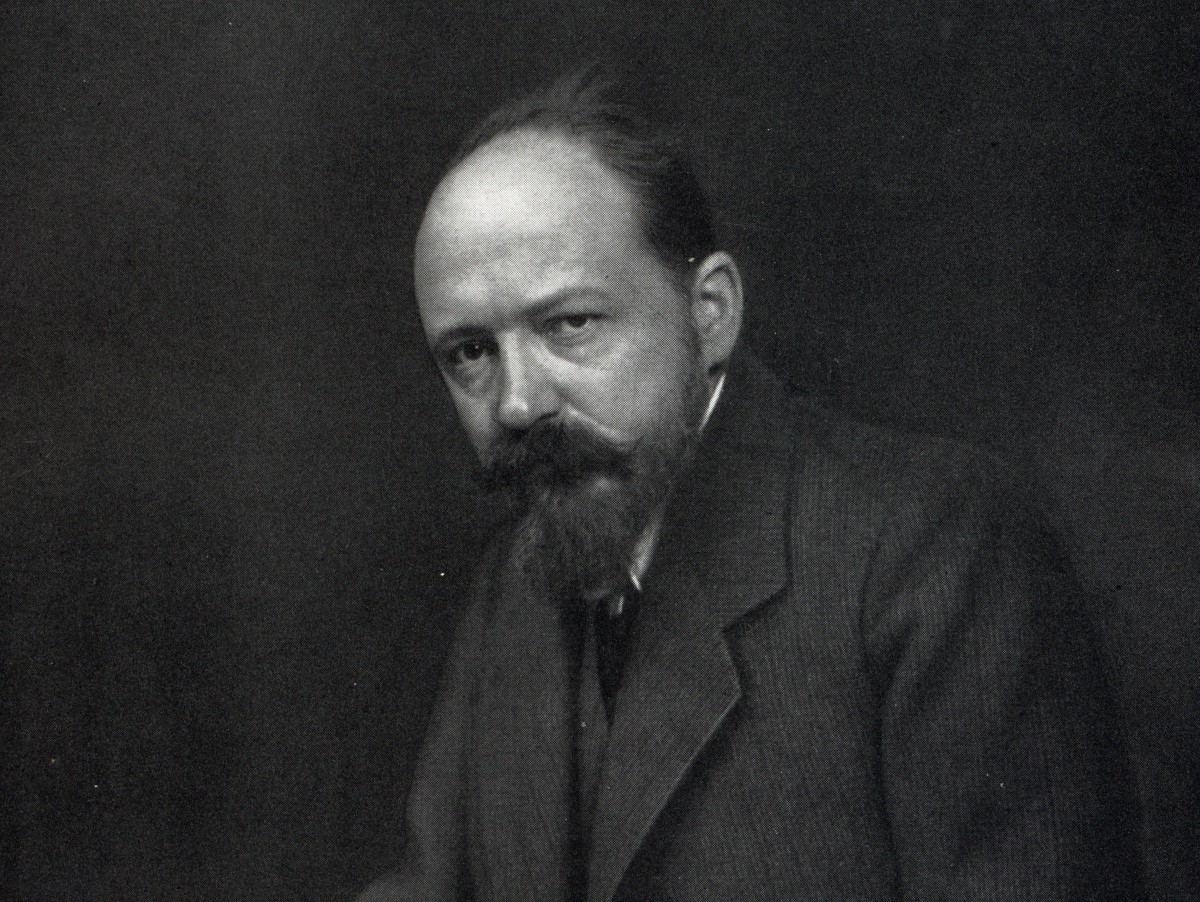
The reconstruction project
The works took eight years to complete, from 1900 to 1908 and the Emperor himself visited the site each year. It was out of the question for the Emperor to reside in the castle, he only wished to restore the ancient ruins.
The castle was to re-establish the era of knights, and a medieval museum was housed within its walls. From the outset, the new castle was set to become a hot spot of tourism in Alsace.
The imposing construction site echoed that undertaken in Pierrefonds by French emperor Napoleon III in 1860. This restoration, led by architect Viollet-le-Duc, was much mocked and criticised.
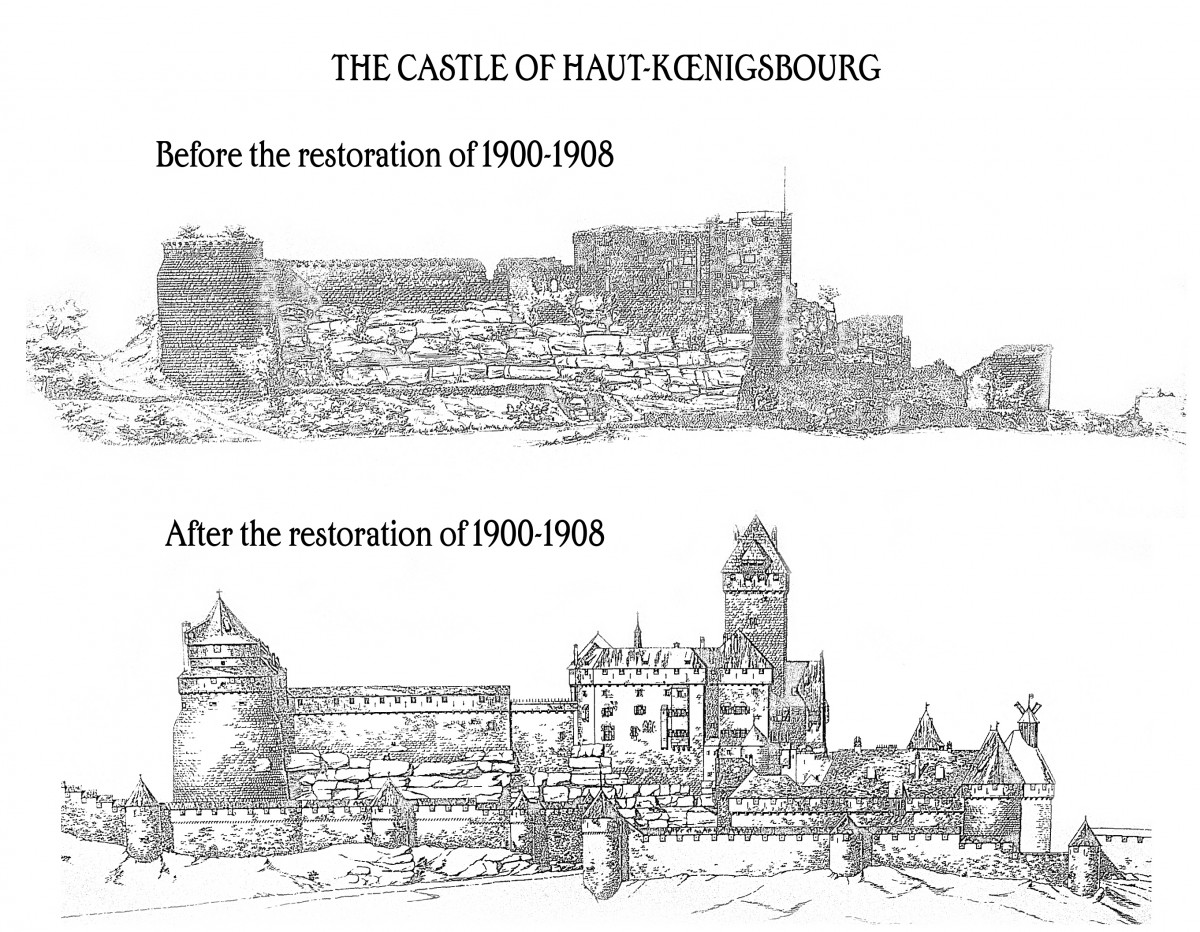
Faithful to the past?
For the architect Bodo Ebhart, the restoration of the Haut-Kœnigsbourg had to adhere faithfully to the past.
Relying upon the architectural principles of medieval times, the young architect from Berlin analysed numerous documents from the local archives with great precision and carried out intensive searches of the castle site.
The foundations and walls still standing were preserved, allowing Ebhart to identify the different parts of the castle and recreate credible settings to restore the ruins authentically.
The Emperor’s choice of Ebhart did not please everyone in the scientific community, and the critics did not wait too long to emerge.
His detractors thought that a renovation risked altering the historic value of the site.
However, it was the renovation of the keep which really came under fire.
Ebhart restored the keep in a square shape (with reason), although the opponents of the plan, who considered the keep should be round, greatly criticised this choice.
Of course, the critics of the restoration decried the ambitious programme in order to voice their resentment at the political symbol of the Emperor in Alsace.
The keep was the first part of the castle to be restored. It had to be a symbol of the power of the new owner – the Emperor.
The imperial eagle was fixed at its top in 1906.
Who was Kaiser William II?

He was born Friedrich Wilhelm Viktor Albrecht von Hohenzollern in 1859. William II was the last German emperor and the last King of Prussia.
He became Emperor in 1888. During his reign, Germany underwent an industrial revolution without comparison and a wave of militarism that transformed the country into a great, modern, and dynamic nation, a new industrial power.
Its aggressive foreign policy put Germany at odds with the United Kingdom and France while moving closer to Austria and Italy.
In 1914, William II declared war against France and the UK, causing the start of the First World War.
William II was passionate about the Middle Ages and the era of knights, hence his ambitious restoration of the Haut-Kœnigsbourg castle.
In the manner of the Marienburg Castle (Malbork, Poland), which marked the Eastern limits of the German empire, the restored Haut-Kœnigsbourg castle combined the symbols of William II with those of other illustrious German emperors such as Charles V (see the coat of arms above the main gate).
The reconstruction of the Haut-Kœnigsbourg Castle
The speed with which the castle was constructed was due to modern techniques: a pump station activated by a petrol engine, a small steam locomotive to carry the stones from the nearby quarry to the site, a sandstone crusher operated by a steam engine and electrified mechanical cranes.
Also, it is said that the construction site of the castle at the top of the mountain was connected to electricity long before the villages in the plain (which didn’t happen until after the First World War!).
The castle’s decoration and furnishing were made possible thanks to a society founded in 1904: the Hohkönigsburgverein (“Society of the Haut-Kœnigsbourg” in German).
This group of university lecturers, architects, and archaeologists, comprising some 400 members, was in charge of installing a collection of artefacts from the Rhineland, such as arms, furniture, and tapestries, in the castle.
Dating from the end of the Middle Ages to the Renaissance, these pieces came from Alsace, Lorraine, Switzerland and as far away as Tirol.
Not all the finishing touches and interior decoration were completed in time for the 1908 inauguration. However, the work continued until the outbreak of the First World War.
The decoration of the “golden chamber” of the keep was left unfinished.
The society’s other mission was to promote the castle as a tourist destination, particularly by introducing an entrance fee.
From its inauguration to the present day
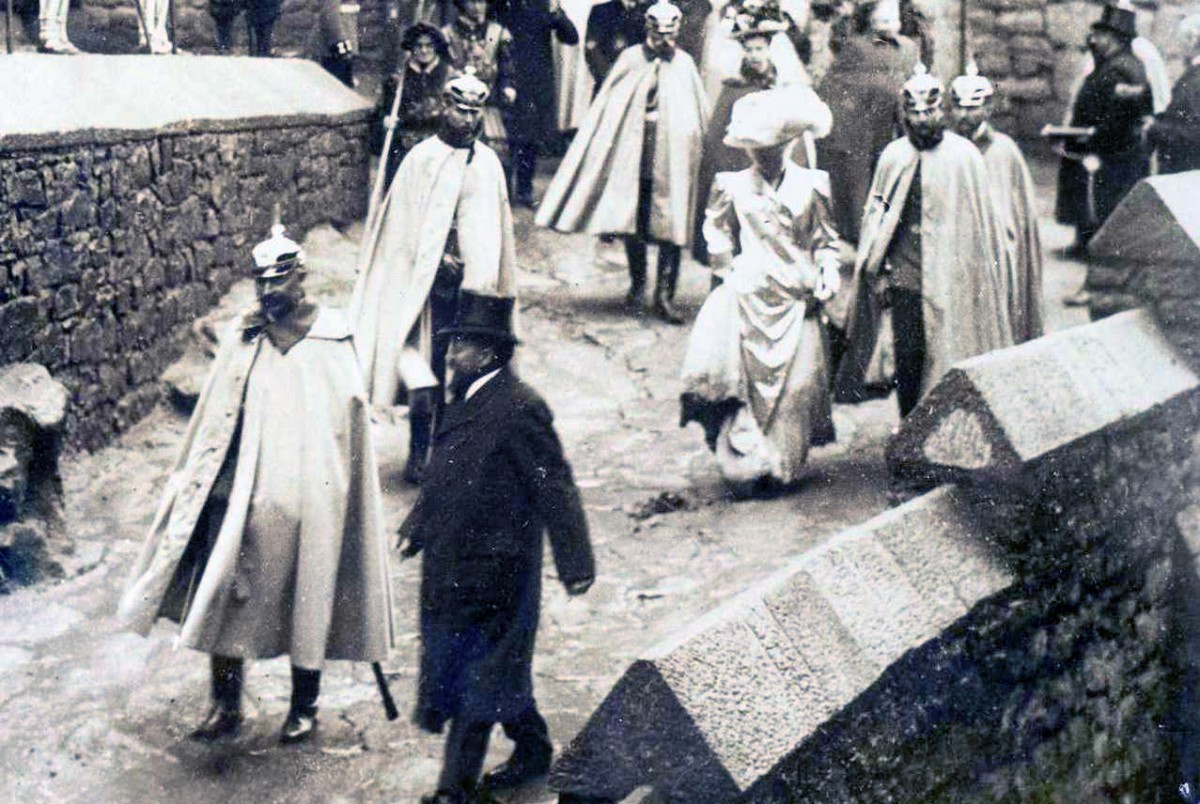
In 1908, the newly restored castle was at last inaugurated in the presence of the Emperor and several other officials.
A great historical parade with more than 500 actors in typical dress was organized during the inauguration ceremony on May 13, 1908.
The parade recalls the storming of the castle by the Sickingen in 1533.
The Alsatian and international press covered the event and made fun of the ceremony, which should have been grand… but took place in the rain!
The castle since 1918
In 1918, after the First World War, the castle became French once again, as did the rest of Alsace and it was spared from further attack during the Second World War.
In 1936, the castle served as the set for a movie by Jean Renoir: “La Grande Illusion” with actor Jean Gabin.
The Haut-Kœnigsbourg Castle was listed as a historic monument in 1993 and acquired by the Conseil Général du Bas-Rhin in 2007. Today, it is recognised as one of the most popular and visited castles in France.
Visiting the Haut-Kœnigsbourg Castle
🏰 Buy your online ticket to the Haut-Koenigsbourg Castle!

At 750 metres above the Alsace Plain, the castle of the Haut-Kœnigsbourg adopts the shape of the rocky outcrop on which it was constructed.
The rampart walls surrounding the fortress measure 270 metres in length and 40 metres in width.
The Lower Courtyard
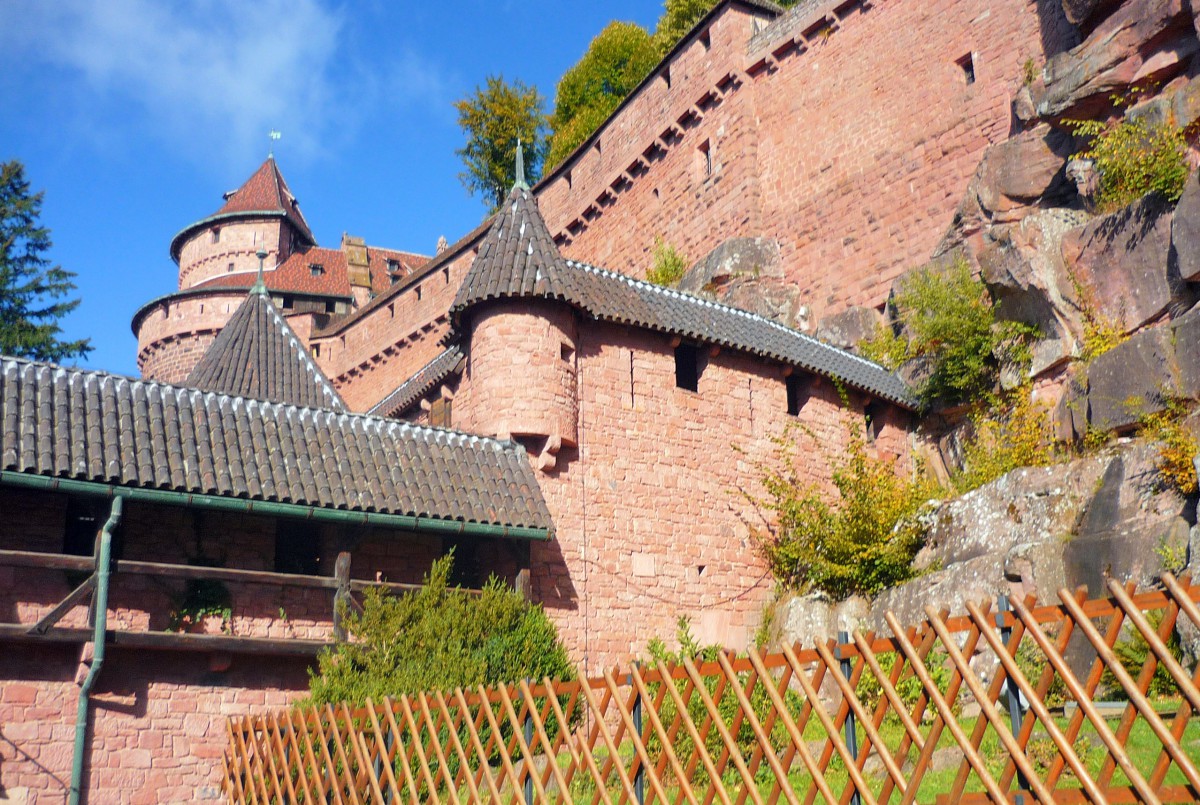
The visitor first enters the castle through the lower courtyard (Cour basse).
Access is through the main gate (porte d’honneur).
When architect Ebhardt restored the castle in the 20th century, it undertook the reconstitution of the gate of which only the foundations existed.
He had the coat of arms of Kaiser William II put above those of Charles V.
This led to much criticism at the time for such a doorway was not faithful to what existed in the Middle Ages.
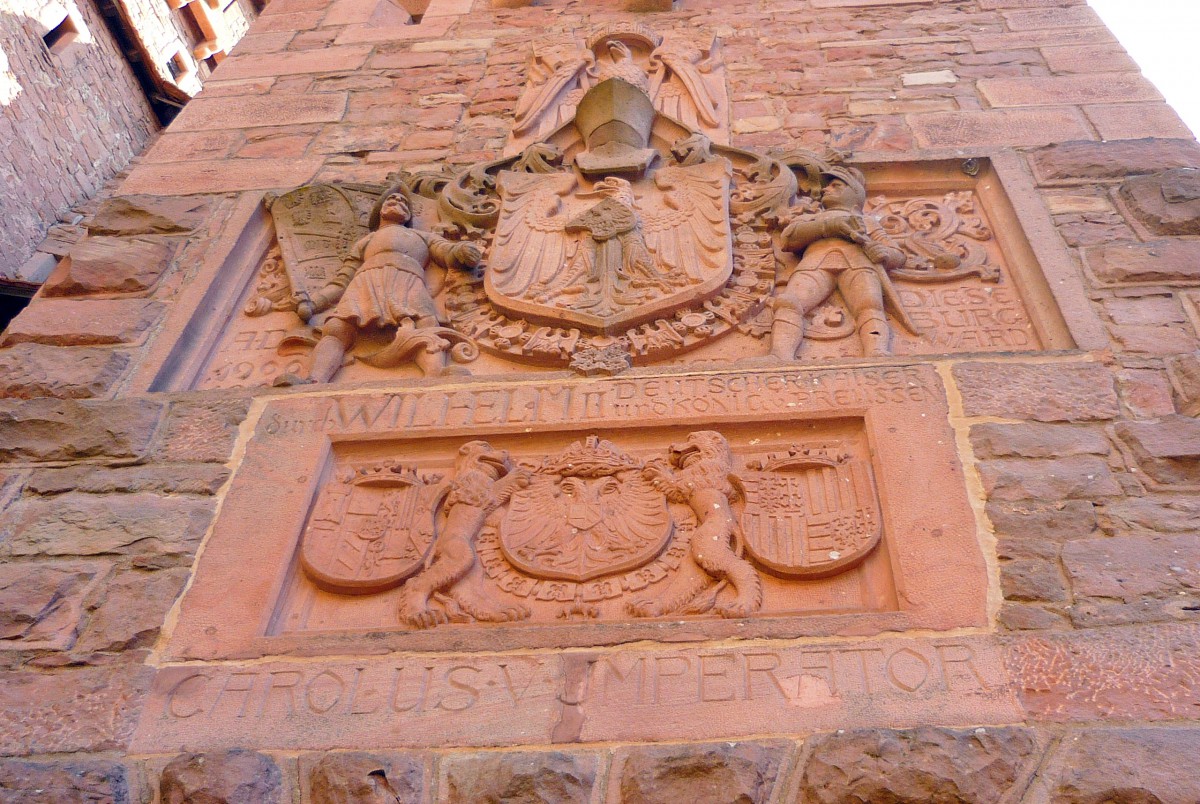
The Lower courtyard is surrounded by a curtain wall and buildings allowing the castle to be autonomous in the event of a siege: a half-timbered inn (called “Alsatian house”, based on a house in the village of Ammerschwihr), stables, a forge and a windmill.
The courtyard features a fountain (a copy of the 15th-century fountain in Eguisheim).
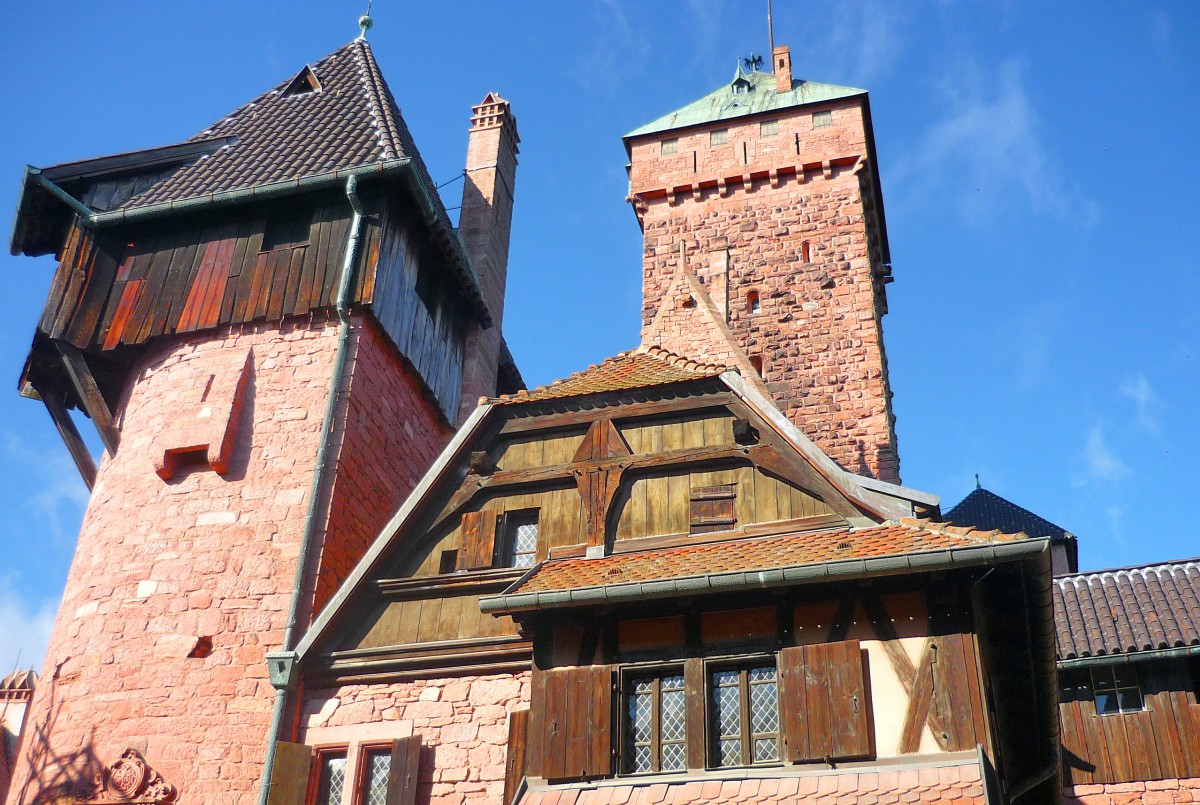
Entrance tickets are checked at the door of the Tower called ” tour du départ de la rampe”.
The lintel of the door holds the coat of arms of the Tierstein, former residents of the castle in the 15th century.
It is surmounted by the coat of arms of the Baron of Bollwiller who lived there in 1606.
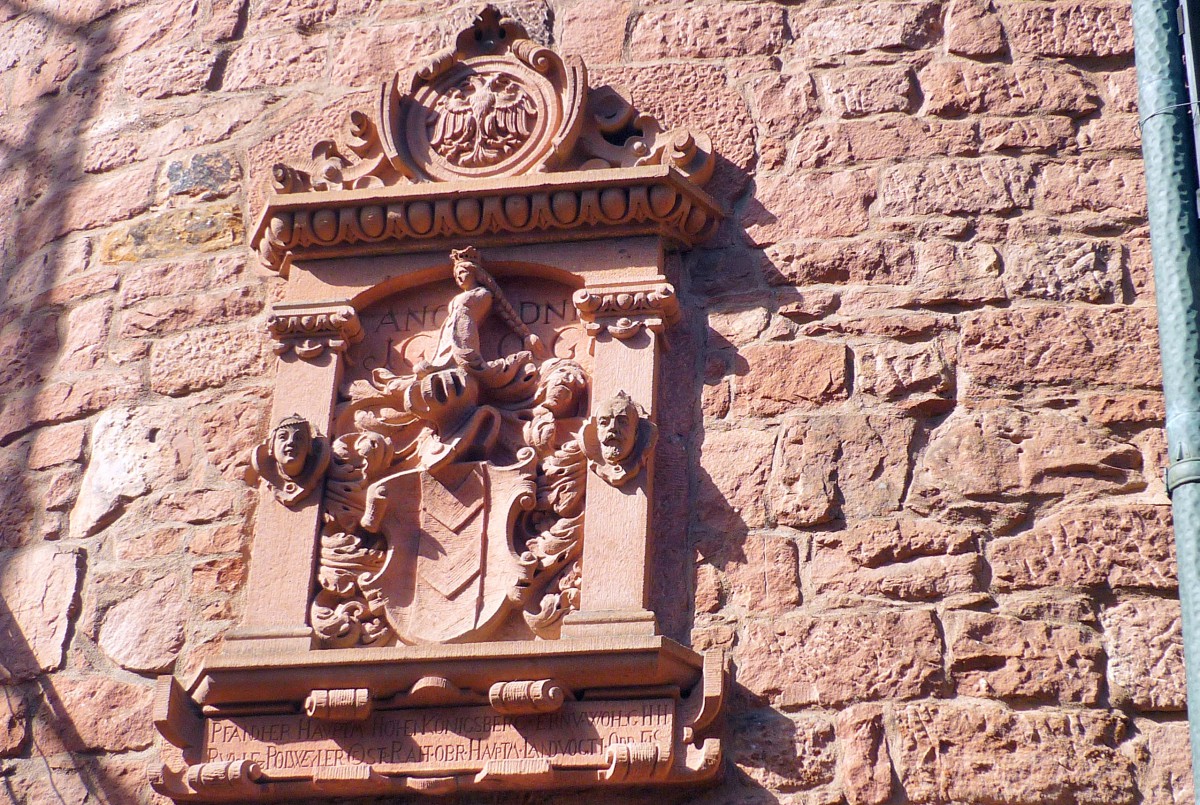
Notice the head that decorates the right pilaster: it is the portrait of the architect!
The drawbridge of the Lions’ Door
The visit starts by following an access ramp to the upper castle which is bordered by loopholes. It leads to the small drawbridge guarding the Well Tower. The bridge crosses a ditch dug in the rock and enters the Lions’ Door (porte des Lions).
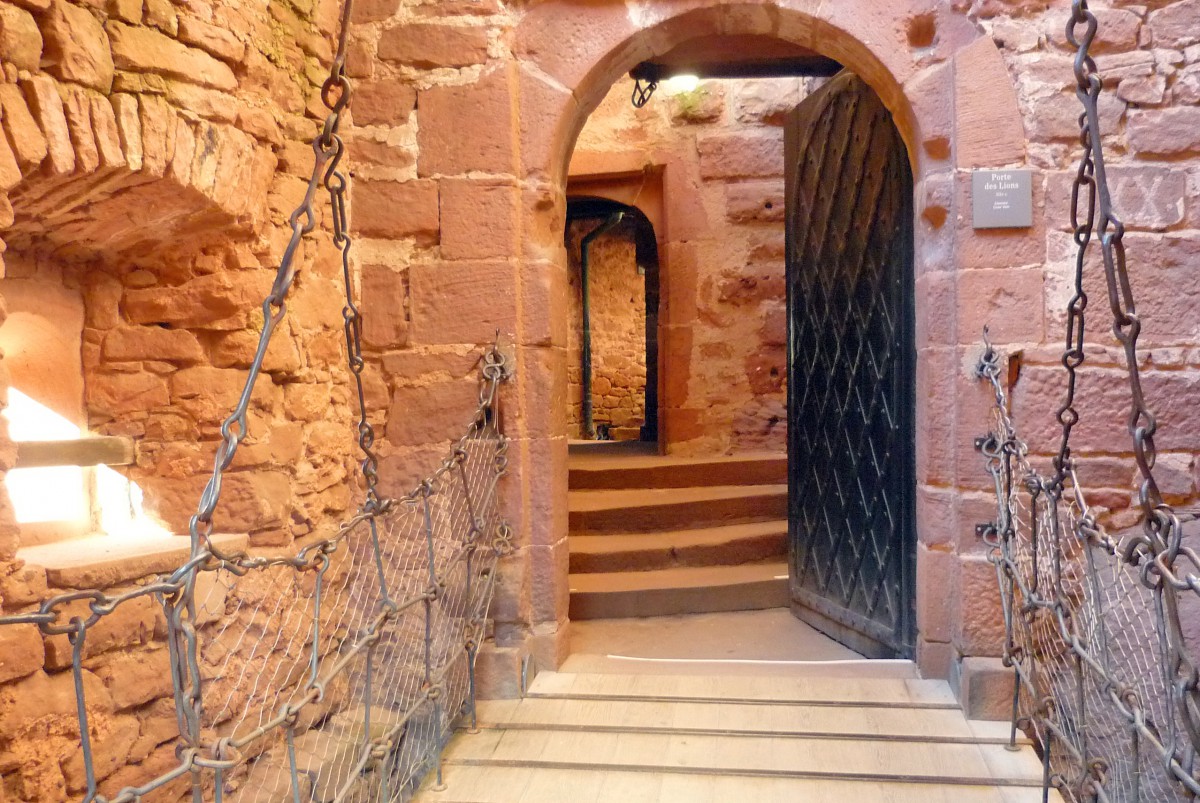
Above the door are two lions guarding the entrance. Symbolically lions were traditional keepers of doors and gates.
The access ramp continues until reaching a beautiful inner courtyard.
The inner courtyard and the main staircase
Once across the bridge, the visitor is led to a beautiful enclosed courtyard known as the inner courtyard.
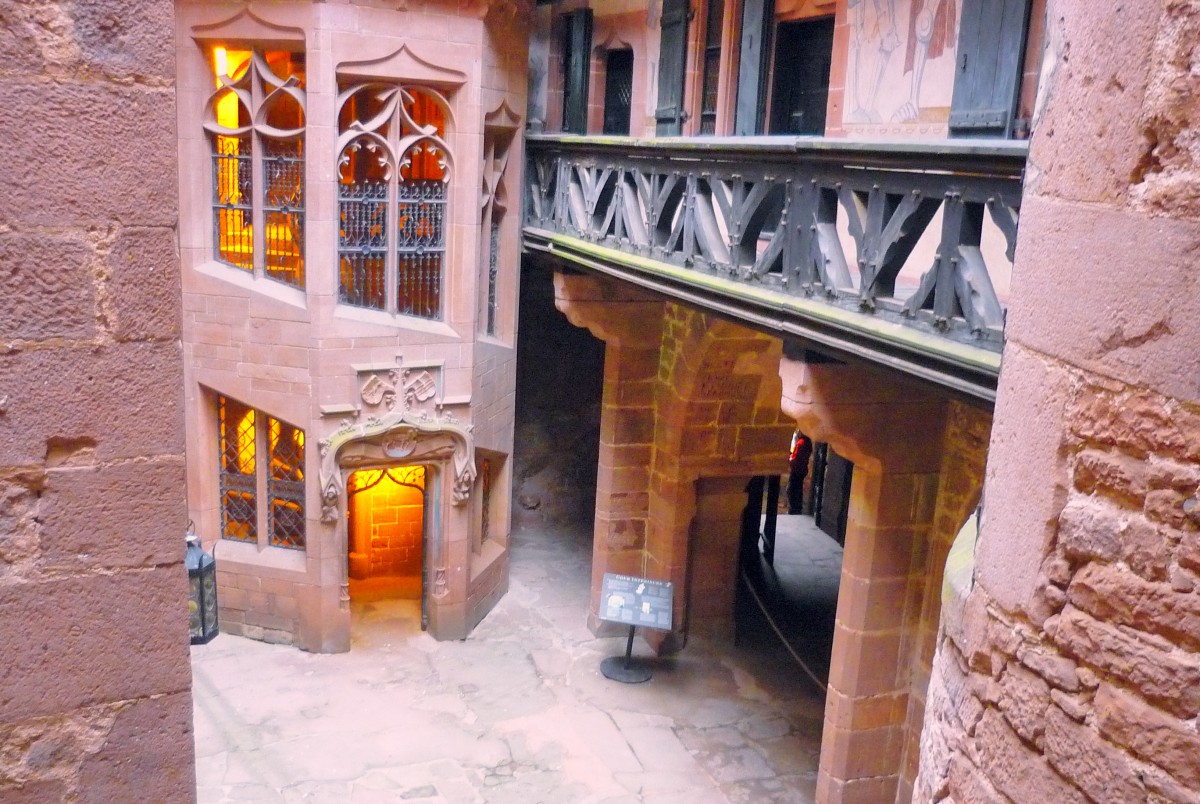
A hexagonal-shaped staircase dating back to the early 20th century takes the visitor to the different floors and chambers of the castle.
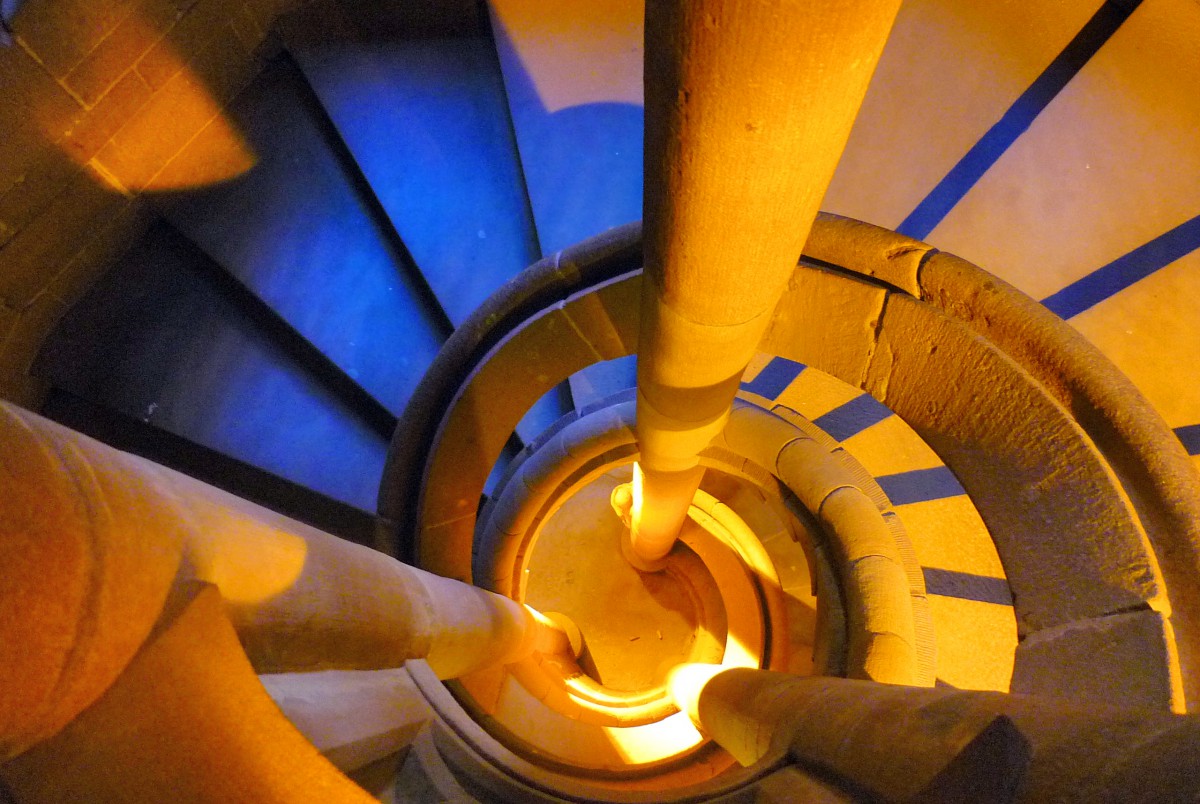
The castle is dominated by a square keep towering 62 metres, with a copper roof that gives it a typical blue-green colour.
To the West, past the upper garden, a second drawbridge leads to the great bastion.
This medieval defensive building is flanked by two towers with a fantastic view over the Alsace Plain and the Vosges.
The first floor of the main building is composed of the northern logis (with a succession of rooms decorated with panelling) and the southern logis (a trophy chamber and a guard room containing a collection of weapons and arms from the late Middle Ages).

The second floor comprises the chamber and antechamber of the Empress, known as the ‘Lorraine Chamber’ and the ‘Kaiser Chamber’.
The latter is decorated with frescoes from the early 19th century, an imperial eagle, and the Prussian motto inscribed on the vault.
Also found here is the coat of arms of the Hohenzollerns.
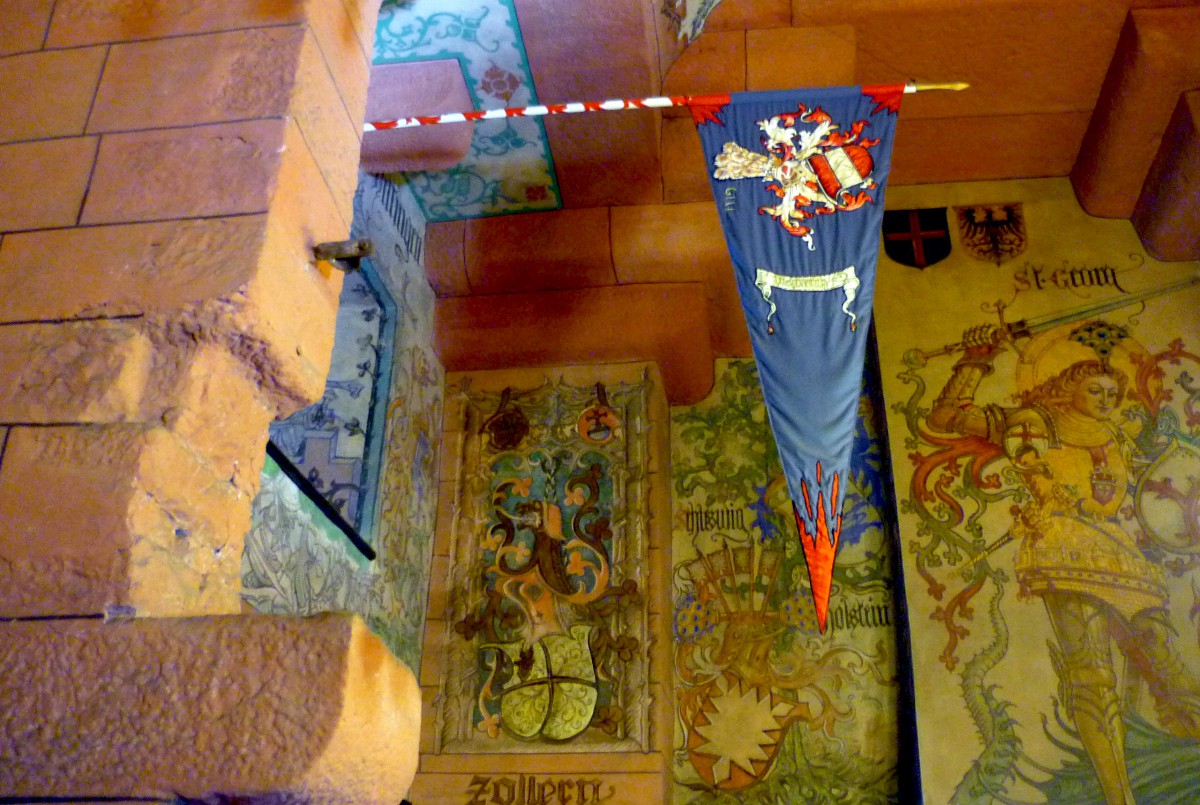
Entirely enclosed, the medieval garden of the Haut-Kœnigsbourg castle was recreated using medieval documents and engravings.
Located just outside the castle, it is made up of squares with wooden plaited borders.
The medieval garden used to serve as a “useful garden” where the castle occupants could find something for nourishment, to cure illnesses, or to dye materials.
Towards the end of the Middle Ages, it became a garden of pleasure, with shady areas and rosebushes inviting for a stroll.
Practical Info

The castle of the Haut-Kœnigsbourg is located 26 km North of Colmar, 55 km South of Strasbourg and 12 km West of Sélestat.
The castle is open all year round, every day except New Year’s Day, May Day and Christmas Day.
To know more about the conditions of visiting the Haut-Kœnigsbourg, go to the official website of the castle.
📸 Click here to buy your entry ticket to the Haut-Koenigsbourg Castle!
Did you like what you read? If so please share it on Facebook or X! 🙂
Pin it for later:
